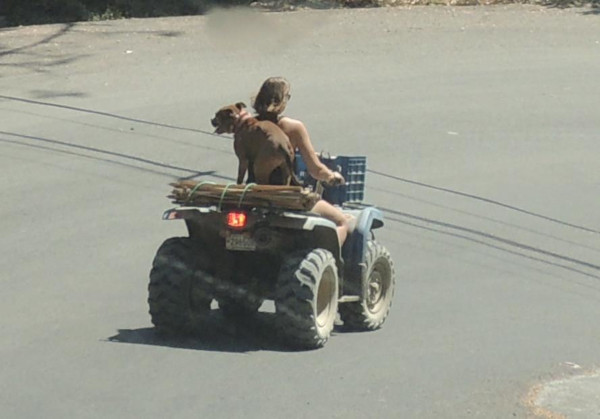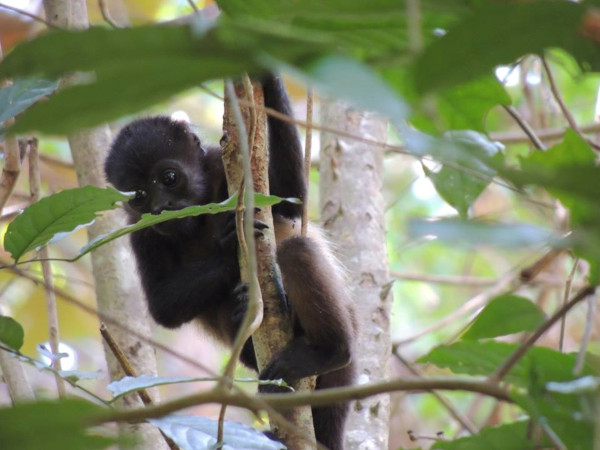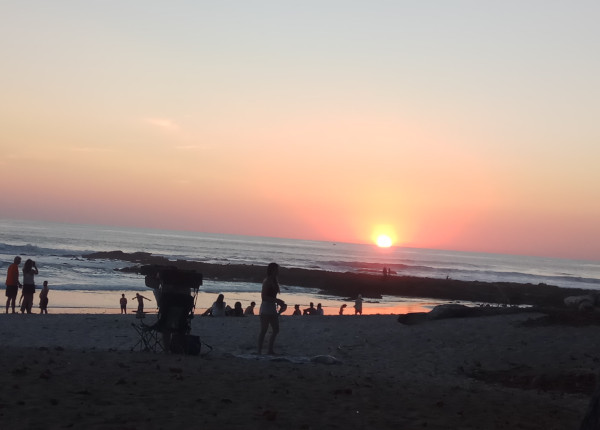|
|
|
sunset at Santa Teresa
Saturday, February 2 2019
location: Casa Trogon, Agua Vista Lodging, Montezuma, Nicoya Peninsula, Costa Rica
Today being the weekend, Gretchen had planned a trip-within-our-trip. Today we'd be driving out to the southern tip and west side of the Nicoya Peninsula. None of this is very far away, but the roads to get there are so terrible that it would take awhile. So Gretchen had reserved us a room at a hotel near Santa Teresa Beach, only 6.33 crow-flying miles to the west. One certainly doesn't want to be driving on Nicoya Peninsula backroads at night.
Our first destination was Cabo Blanco Absolute Natural Reserve, a 3000 acre preserve (and supposedly the first of the network of parks that gives Costa Rica its reputation on the forefront of ecological preservation). To get there, we drove into downtown Montezuma and then took the crappy dirt road southwest along the coast. Once out of "town," we could drive faster than human walking speed, though it was rare we could go even as fast as 40 kilometers/hour.
It cost us a total of $24 to get into Cabo Blanco. I think Gretchen wanted to walk on the big loop, but I've been loathe to go on long trudging walks in a forest since doing it on a regular basis with my father as a teenager and young adult. I particularly dislike walks where one hikes out on the same trail one hikes in on. It feels like digging a hole just to fill it back in again. But I digress: we took the short loop, which Gretchen later admitted was probably a good idea. Being at the reserve on a hot mid-morning, we didn't see much in the way of wildlife, and, aside from some large trees with fancy root buttresses, there wasn't much of botanical note either. The most impressive thing was how the trail had been constructed. Much of it had been paved with big concrete blocks having the shape of a hash ("#"), with the voids partially-filled with soil. These provided good traction four our shoes while also limiting the potential damage of erosion, though it couldn't've been easy to haul hundreds of those heavy things into the jungle. I joked that they resembled waffles and that someone in the parking lot could do a brisk business if they set up a waffle stand, given all the subliminal advertising.
A little over halfway through the small loop, we finally came upon some wildlife: a mother howler monkey with her little baby. We stood there beneath them for a long time watching them eating vegetation. I snapped a bunch of photos, only a couple of which turned out any good.
Our next stop was Mal Pais on the Pacific-facing west coast of the Peninsula. We randomly selected a restaurant called Caracolas for lunch and it turned out to be a perfect place. We had seating close to the beach but in the shade, and the food options were excellent. We ordered vegan nachos which came with a cashew cheese, and I also had some sort of watery Costa Rican lager. While we ate, we could see surfers off in the distance catching waves from a point break. As we were leaving, we accidentally wandered into the owner's semi-outdoor private residence. He chatted with us briefly as I petted his dog Jack, which might've been a purebred boxer. I could see lots of live fleas in Jack's fur, though they didn't seem to trouble him much.
By Nicoya Peninsula standards, the beachside road up to Santa Teresa Beach wasn't bad. It was mostly paved, and didn't contain all that many potholes. The hotel where we would be staying was called Raratonga and was centered around a mid-sized pool with a couple loud kids in it. Our room was high up and had a balcony that nobody had any reason to walk on (though we had to walk through someone else's balcony to get to our room). It's interesting to note that this was the first time Gretchen and I had ever rented a room away from another room we were also renting, meaning this really was a trip within a trip.
I wasn't in a mood to do anything when Gretchen wanted to go for a walk on the beach, so I stayed back in the room and even nodded off for a bit.
Eventually, though, I rallied and walked to a nearby supermarket (Supermarket La Hacienda) to get a few supplies: a sixpack of Imperial Silver (which turned out to be a light beer, oh well), a small amount of ground coffee (for our room here at Raratonga), and a small tube of antifungal cream to treat my athlete's food, which had started flaring up on my left foot yesterday even though I hadn't worn shoes in a couple of days. The Supermarket La Hacienda had lots of good food in it, including a good diversity of hot sauces and cans of that Roland tofu.
After she got back from her walk along the beach, Gretchen thought it important for us to go somewhere like a beachside bar to catch the sunset. So we walked about a kilometer west to a beachside restaurant (either Rocamar or an adjacent place). A very blond waitress told us (in Spanish) that we couldn't have a table unless we ordered food but that she would gladly fetch us beverages if we sat in the hammock or a beachside chair. So we ordered drinks and set up in the hammock to watch the surfers and the setting sun. I've been to a fair number of surfing spots in and around San Diego and Los Angeles, but I've never seen as many surfers as were visible here along Santa Teresa beach. It's understandable; the water is much warmer and there's no private beach to contend with (as in Mexico, all beach in Costa Rica is public). As for the sunset, it went the way all sunsets go. The sun gradually dropped until it had a point of adhesion to the horizon, which proceeded to slurp it up over the course of two minutes or so. What didn't get slurped up was those drinks we'd ordered, which that blond waitress never bothered to deliver.
I was nervous to walk back along the beach road after sunset. But then Gretchen had the idea of just walking back along the beach. That way we could watched the surfers and meet a great many beach dogs, all of them happy and healthy.
As we returned to our hotel, I noticed a thick stench of fresh manure in the air. Gretchen thought it came from the sewers on either side of the beach road, but I didn't think so. I was pretty sure we were smelling shit that had been crapped under the bushes by the beach's many human (and perhaps also canine) occupants, many of them living in various stages of joyous homelessness.
After some deliberation and internet research, Gretchen decided we should walk a kilometer east down the beach road to dine at an Asian restaurant called
Suna. I was nervous to walk that route after dark, but there were plenty of street lights and other pedestrians, so it wasn't as scary as I had feared (despite the occasional idiot on a loud motorbike driving at speeds calculated to impress the kind of woman no one should ever want to sleep with.
The service at Suna was terrible, and it wasn't just our waitress who was the problem. Gretchen watched the vaguely-gothy woman working the bar take 15 minutes to make a single drink. Clearly, Gretchen decided, she'd been hired for her looks. But when the food came out, it was amazing. I'd ordered the curry burrito with tofu and it was much better than expected. And Gretchen definitely had winner with whatever noodle dish she'd ordered. My mango margarita was slow in coming, but the salt seemed to work better with the mango than it does with lime. As we ate, we watched the people and dogs going by on the street below, some of them on big beefy four-wheelers. Most of the people looked to be American ex-pats who'd come here to chill out on the beach for awhile, though some looked like they were now stuck in a different track of life. Most of the women were carrying food or babies, while the men were mostly getting beer at the Super Ronny's or carrying big jugs of water, indicated a lack of gringo faith in Santa Teresa's infrastructure. We'd been drinking the tapwater back at our casita since being told it was fine to drink, and so now we were in the habit. But tonight after drinking some tapwater in our Raratonga room, I wondered if perhaps that had been a bad idea.
 A woman with her dog (and a bundle of sticks) driving down the switchbacks into Montezuma as we were driving to the west side of the peninsula.
A woman with her dog (and a bundle of sticks) driving down the switchbacks into Montezuma as we were driving to the west side of the peninsula.
 A baby howler monkey in the jungle at Cabo Blanco Absolute Natural Reserve
A baby howler monkey in the jungle at Cabo Blanco Absolute Natural Reserve
 Sunset at Santa Teresa.
Sunset at Santa Teresa.
For linking purposes this article's URL is:
http://asecular.com/blog.php?190202 feedback
previous | next |
 A woman with her dog (and a bundle of sticks) driving down the switchbacks into Montezuma as we were driving to the west side of the peninsula.
A woman with her dog (and a bundle of sticks) driving down the switchbacks into Montezuma as we were driving to the west side of the peninsula.
 A baby howler monkey in the jungle at Cabo Blanco Absolute Natural Reserve
A baby howler monkey in the jungle at Cabo Blanco Absolute Natural Reserve
 Sunset at Santa Teresa.
Sunset at Santa Teresa.